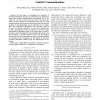Free Online Productivity Tools
i2Speak
i2Symbol
i2OCR
iTex2Img
iWeb2Print
iWeb2Shot
i2Type
iPdf2Split
iPdf2Merge
i2Bopomofo
i2Arabic
i2Style
i2Image
i2PDF
iLatex2Rtf
Sci2ools
ICRA
2007
IEEE
2007
IEEE
Multi-Robot Formations based on the Queue-Formation Scheme with Limited Communications
— In this paper, we investigate the operation of the Queue-formation structure (or Q-structure) in multi-robot teams with limited communications. Information flow is divided into two time scales: (i) the fast time scale where the robots’ reactive actions are determined based only on local communications, and (ii) the slow time scale, where information required is less demanding, can be collected over a longer time with intermittent information loss. Therefore, there is no need for global information at all times, reducing the overall communication load. In addition, a dynamic target determination algorithm, based on the Q-structure, is used to produce a series of targets that incrementally guide each robot into formation. It provides greater control over the distance between robots on the same queue for better formation scaling. An analysis of the convergence of the system of robots is provided. Simulation studies verify the effectiveness of the scheme.
| Added | 03 Jun 2010 |
| Updated | 03 Jun 2010 |
| Type | Conference |
| Year | 2007 |
| Where | ICRA |
| Authors | Cheng-Heng Fua, Shuzhi Sam Ge, Khac Duc Do, Khiang Wee Lim |
Comments (0)

